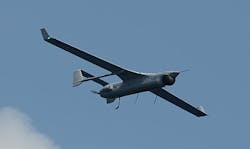Navy buys one Insitu RQ-21A Blackjack UAV in preparation for ramping-up production
PATUXENT RIVER NAS, Md., 28 Nov. 2013. U.S. Navy officials are buying one new tactical unmanned aerial vehicle (UAV), intended as an organic and dedicated multi-intelligence UAV for U.S. Marine Corps and Navy tactical commanders, in preparation for ramping-up production of the front-line tactical unmanned aircraft.
Officials of the Naval Air Systems Command at Patuxent River Naval Air Station, Md.,awarded an $8.8 million contract this week to Boeing Insitu Inc. in Bingen, Wash., for one low-rate-initial-production II RQ-21A Blackjack UAV, to include air vehicles, ground control stations, launch and recovery equipment, and air vehicle support equipment.
The Boeing Insitu RQ-21 is a twin-boom, single-engine, monoplane UAV for surveillance and reconnaissance. It an be launched and recovered on land or at sea without runways, using a pneumatic launcher and net-type recovery system.
The Blackjack -- so-named last September -- is eight feet long with a 16-foot wingspan designed to carry multi-sensor payloads in large pod below its nose. The UAV can fly as fast as 104 miles per hour, cruises at 63 miles per hour, can fly as long as 24 hours, and can fly as high as 19,500 feet. It is a version of the Insitu Integrator UAV.
The multi-mission RQ-21A Blackjack's open-architecture payload bays can be customized with visible-light and infrared cameras, communications and other tools to give warfighters on the forward edge of battle situational awareness information.
It can integrate new payloads quickly, offers roll-on, roll-off capability to move the system quickly from ship to shore, and aboard cargo aircraft. The UAV can carry sensor payloads as heavy as 39 pounds.
The Blackjack's standard sensor payload consists of a visible-light imager, mid-wave infrared imager, laser rangefinder, infrared marker, communications, and Automatic Identification System (AIS).
The RQ-21A will provide persistent maritime and land-based tactical reconnaissance, surveillance, and target acquisition (RSTA) data collection and dissemination capabilities to the warfighter.
For the Marine corps it will provide the marine expeditionary force, divisions, and regiments with a dedicated intelligence, surveillance, and reconnaissance (ISR) system that sends information to the tactical commander in real time.
For the Navy the Blackjack will provide persistent RSTA information to Navy ships, Marine Corps land forces, Navy expeditionary combat command forces and Navy special warfare units.
In the future the U.S. Air Force may use the RQ-21A for persistent RSTA for security forces, integrated base defense, convoy protection, and weather analysis.
On the current contract, Boeing Insitu will do the work in Bingen, Wash., and should be finished by next May. For more information contact Boeing Insitu online at www.insitu.com, or Naval Air Systems Command at www.navair.navy.mil.

